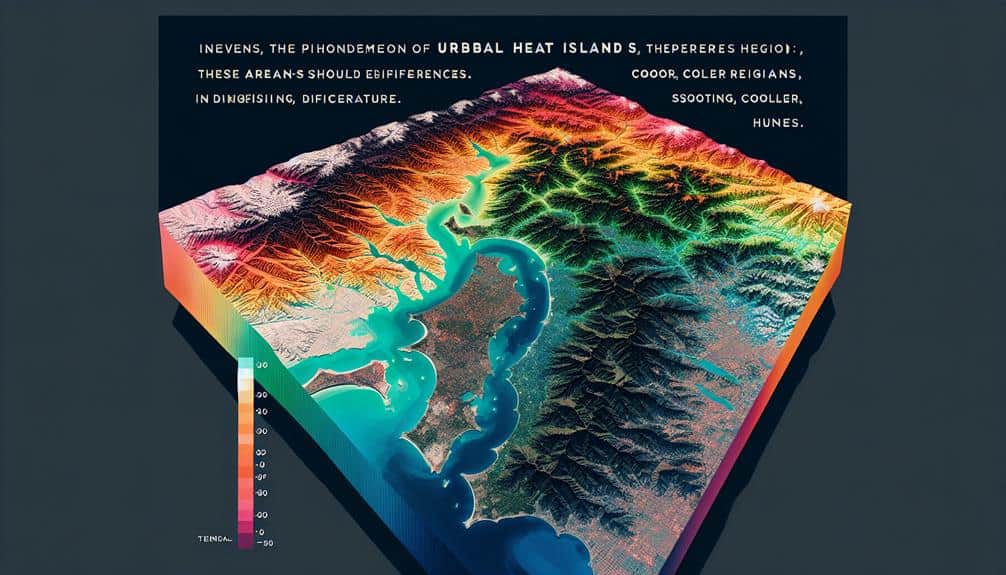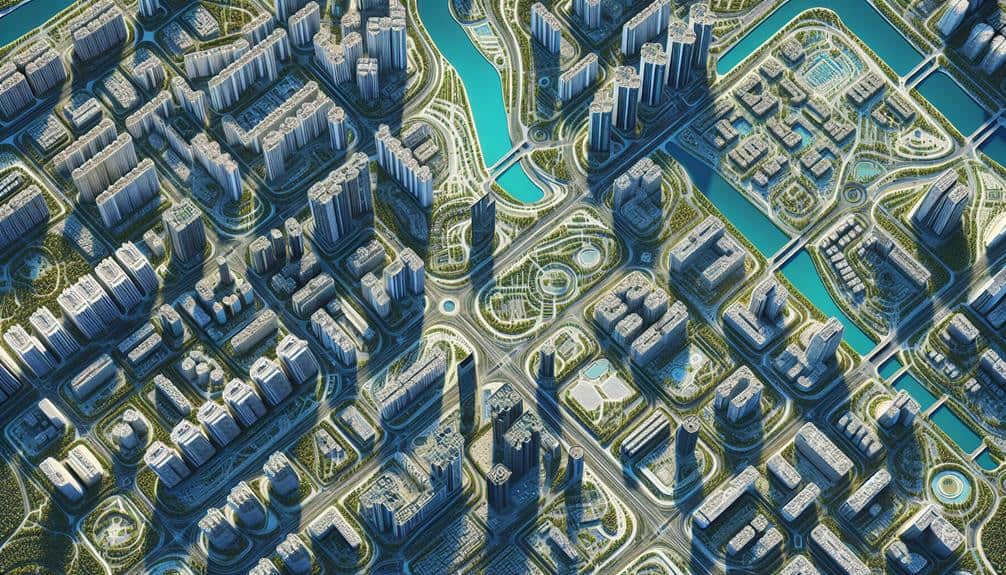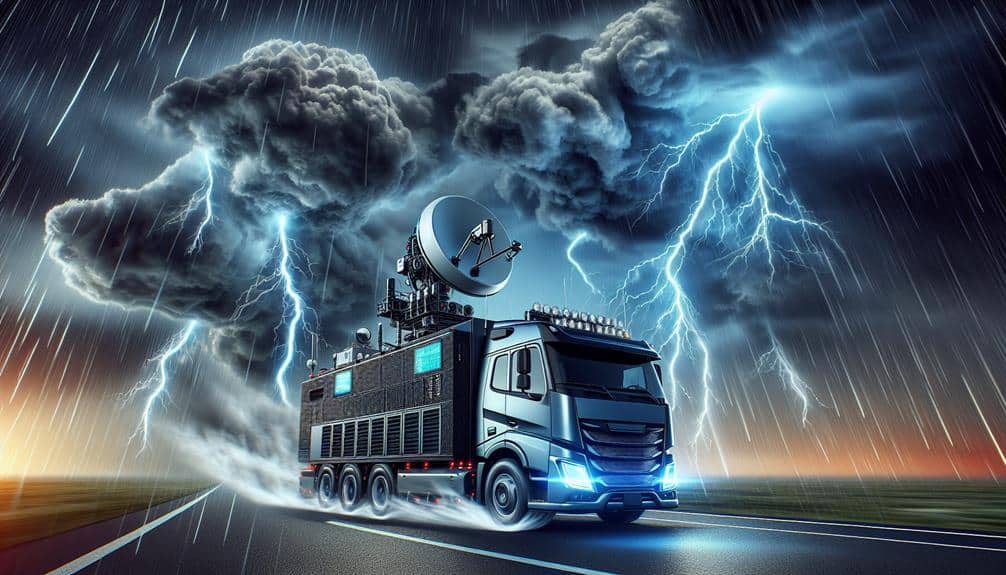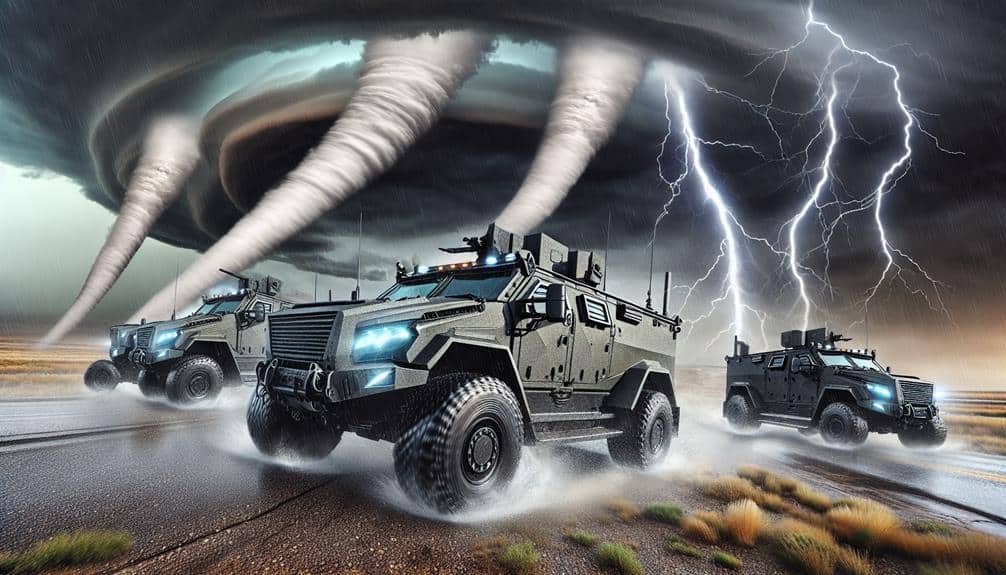We can improve our use of satellite imagery by first grasping its fundamentals and selecting the appropriate satellite for our requirements. Examining past data aids us in monitoring environmental changes and predicting weather. Observing cloud formations and temperature fluctuations offers understanding into climate dynamics. Through detailed images, we can identify slight alterations in vegetation and urban growth. Live feeds and incorporation of ground data enrich our analysis, while forecasting models convert unprocessed data into practical insights. These measures guarantee we optimize accuracy and data-informed decision-making. For more profound understanding, there's plenty more to explore.
Key Points
- Use high-resolution images to detect subtle environmental and urban changes with precision.
- Integrate real-time feeds to enhance data visualization and improve emergency responses.
- Leverage predictive models to transform raw data into actionable insights and accelerate analysis.
- Validate satellite data with ground surveys and GNSS technology for comprehensive understanding.
Understand Satellite Basics
To effectively utilize satellite imagery, we must first understand the fundamental principles of how satellites capture and transmit data.
Satellites operate in various orbits, each offering different vantage points and data resolution capabilities. For instance, geostationary satellites, positioned over the equator, provide continuous coverage of the same area, which is invaluable for real-time monitoring.
Conversely, polar-orbiting satellites move in a north-south direction and can cover the entire globe, offering high-resolution data ideal for detailed analysis.
Remote sensing technology underpins satellite imagery, enabling us to gather information about Earth's surface without direct contact. Through sensors, satellites detect electromagnetic radiation reflected or emitted from the terrain. This data is then processed and converted into images that we can interpret to gain insights.
High data resolution is essential here; it determines the level of detail in the images. Higher resolution means finer details, which is vital for applications like urban planning or environmental monitoring.
Image interpretation involves analyzing these processed images to identify patterns, changes, and objects. By mastering these basics, we can access the full potential of satellite imagery, empowering us to make informed decisions and achieve greater flexibility in our endeavors.
Choose the Right Satellite
Selecting the appropriate satellite involves analyzing mission objectives, data requirements, and the specific characteristics of available satellites. First, we must define our mission objectives clearly. Are we monitoring environmental changes, mapping urban areas, or gauging agricultural health? Each task demands different satellite capabilities.
Next, we consider the required data granularity. High-resolution satellites can capture intricate details, ideal for urban planning or disaster response. Conversely, lower-resolution satellites offer broader coverage, useful for large-scale environmental monitoring.
Assessing satellite resolution is crucial. For example, a resolution of 30 cm per pixel provides excellent detail, capturing individual trees or vehicles. However, such high resolution may come at the cost of reduced temporal frequency. We must balance the need for detail against the frequency of data capture.
Additionally, we should examine the spectral capabilities of the satellite. Multispectral and hyperspectral sensors can detect various wavelengths beyond the visible spectrum, providing insights into vegetation health, soil moisture, and water quality.
Lastly, we need to account for satellite availability and revisit rate. Frequent updates are essential for dynamic environments. By carefully evaluating these factors, we can select a satellite that aligns perfectly with our project's goals, ensuring both precision and efficiency in data acquisition.
Analyze Historical Data
Analyzing historical data allows us to identify long-term trends and patterns that are essential for informed decision-making in various applications. When we explore past satellite imagery, we gain the ability to make predictions and strategize effectively.
Leveraging data visualization techniques and statistical analysis methods, we can uncover insights that might otherwise go unnoticed. By integrating machine learning applications, we further enhance our predictive capabilities. Geographic information systems (GIS) also play a critical role in mapping and interpreting spatial data.
Consider these benefits of analyzing historical satellite data:
- Environmental Monitoring: Track changes in land use, deforestation rates, and urban expansion.
- Agricultural Planning: Analyze crop health trends and predict future yields.
- Disaster Management: Assess areas prone to natural disasters and improve emergency response strategies.
- Climate Studies: Examine long-term climate patterns and predict future climate changes.
Monitor Cloud Patterns
When we monitor cloud patterns via satellite imagery, we can accurately identify weather systems and predict storm development.
By analyzing cloud formations and their movements, we gain critical insights into atmospheric conditions.
This data-driven approach enhances our ability to forecast severe weather events with greater precision.
Identifying Weather Systems
Monitoring cloud patterns via satellite imagery provides necessary data for accurately identifying and tracking weather systems. By analyzing cloud formations, we can recognize and predict weather phenomena that have significant implications for storm tracking, disaster response, climate change, and environmental impact.
Satellite imagery enables us to detect:
- Cyclones and Hurricanes: By observing rotating cloud masses, we can identify the formation and trajectories of cyclones and hurricanes, vital for early warnings and disaster response.
- Frontal Systems: Distinct cloud bands indicate cold or warm fronts, helping us forecast precipitation events and temperature changes.
- Thunderstorms: Dense, towering cumulonimbus clouds signal severe thunderstorms, allowing us to issue timely alerts to mitigate damage.
- Cloud Cover Extent: The extent and type of cloud cover can influence local climate patterns and impact environmental conditions.
Our ability to monitor and interpret these patterns is essential for mitigating the effects of severe weather and understanding long-term climate dynamics. By leveraging this data, we're better equipped to protect communities, respond quickly to natural disasters, and assess the broader environmental impacts of climate change.
Let's harness the power of satellite imagery for a safer, more informed world.
Predicting Storm Development
Building on our ability to identify weather systems, we can predict storm development by closely examining the evolution of cloud patterns captured in satellite imagery. By analyzing these patterns, we gain vital insights into atmospheric dynamics, allowing us to anticipate storm formation and progression with remarkable accuracy. Satellite technology, with its real-time data capture and high-resolution imagery, is essential for storm tracking.
When we monitor cloud patterns, we focus on factors such as cloud shape, density, and movement. Rapid changes in these elements often signal the early stages of storm development. For instance, the formation of cumulonimbus clouds, characterized by towering, dense structures, can indicate an impending thunderstorm. By using satellite data to observe these changes over time, we can generate predictive models that provide early warnings.
Moreover, understanding storm development is critical in the context of climate change. As global temperatures rise, storm patterns are becoming more unpredictable. Satellite data helps us track these shifts, offering a thorough view of how climate change is altering weather phenomena. This analytical precision empowers us to make informed decisions, bolstering our preparedness and resilience in the face of increasingly volatile weather patterns.
Detect Temperature Changes

Satellite imagery provides an indispensable tool for accurately detecting and analyzing temperature changes across vast geographic areas. With this technology, we can pinpoint climate shifts and analyze urbanization trends with remarkable precision. This allows us to make informed decisions based on solid data. By leveraging satellite imagery, we're not just observing; we're tracking and understanding the intricate dynamics of our planet.
Satellite imagery enables us to:
- Detect climate shifts: Identify and monitor changes in temperature patterns over time, providing early warnings for climate-related events.
- Analyze urbanization trends: Observe how expanding cities affect local climates, enabling urban planners to make more sustainable decisions.
- Track deforestation: Monitor regions where forests are being cleared, which impacts local and global temperatures.
- Monitor wildlife habitats: Assess the effects of temperature changes on ecosystems, helping in the conservation of endangered species.
Using satellite imagery, we can harness data-driven insights to understand temperature changes with analytical precision. This empowers us to act proactively, ensuring a sustainable and resilient future. Let's embrace this freedom to explore and protect our planet with unparalleled accuracy.
Identify Wind Shear Zones
By leveraging advanced satellite technology, we can accurately identify wind shear zones, which are crucial for aviation safety and weather forecasting. Wind shear, the sudden change in wind speed and direction, poses significant hazards, especially during takeoff and landing. Our ability to perform precise wind shear analysis through satellite imagery allows us to mitigate these risks effectively.
Remote sensing applications enable us to collect detailed atmospheric data. This data, when subjected to rigorous data interpretation, reveals in-depth insights into wind patterns. Satellites equipped with Doppler radar and other advanced sensors capture high-frequency measurements of wind velocity and direction across different altitudes. This facilitates the identification of wind shear zones with unparalleled accuracy.
In meteorological studies, pinpointing these zones is essential. We assess the vertical and horizontal gradients in wind speed and direction to understand the shear's intensity and potential impact. The integration of satellite data into meteorological models enhances our predictive capabilities, providing timely warnings and improving flight safety protocols.
Use High-Resolution Images

High-definition images provide us with the detailed information necessary to analyze environmental changes and landscape features with precision. When we opt for the highest image resolution available, we're accessing a wealth of data that can greatly enhance our assessments.
High-definition satellite imagery ensures data accuracy by capturing minute details that lower resolutions might overlook. This level of detail is crucial for making informed decisions and executing precise actions.
With high-definition images, we can:
- Detect subtle changes in vegetation: Observe seasonal transformations and evaluate plant health.
- Monitor urban development: Track construction progress and land use changes with pinpoint accuracy.
- Identify water bodies and boundaries: Precisely delineate rivers, lakes, and coastal lines.
- Assess natural disaster impacts: Analyze flood extents, landslide areas, and wildfire damage with clarity.
Incorporate Real-Time Feeds
How can we enhance our analysis and decision-making processes by incorporating live satellite feeds?
By leveraging current data, we can improve our capacity for data visualization and machine learning applications. For example, live satellite feeds provide up-to-the-minute insights that are essential for crop monitoring. We can detect anomalies, assess crop health, and predict yields more accurately. This allows us to make timely interventions, optimizing agricultural productivity and resource allocation.
In the domain of disaster response, live feeds are indispensable. They enable us to monitor evolving situations such as wildfires, floods, or hurricanes with unmatched immediacy. This rapid access to current data allows for more effective deployment of emergency services, potentially saving lives and reducing damage. Machine learning algorithms can further analyze these live images to predict the spread of a disaster, offering a proactive rather than reactive approach.
Incorporating live satellite feeds into our workflows not only enhances our analytical precision but also provides the freedom to act swiftly and decisively.
Integrate With Ground Data

Combining satellite images with ground data allows us to validate and enrich our analyses, providing a more comprehensive understanding of the observed phenomena. By performing ground validation and accuracy evaluation, we can verify that our satellite-derived insights are both reliable and actionable.
Integrating these two data sources—referred to as data fusion—enables us to create a more nuanced and precise picture of the landscape.
To achieve effective image integration, we should focus on the following:
- Calibration of satellite sensors: Ensuring that the satellite data aligns with on-the-ground measurements.
- Field surveys: Collecting real-time data from the ground to compare against satellite imagery.
- Use of GNSS technology: Enhancing locational accuracy for ground data points.
- Cross-referencing historical data: Establishing a baseline for evaluating changes and trends over time.
Leverage Predictive Models
Let's harness predictive models to analyze temporal patterns in satellite imagery. This allows us to forecast changes with greater accuracy.
By integrating these models, we can enhance data accuracy and make more informed decisions.
This approach transforms raw satellite data into actionable insights.
Analyze Temporal Patterns
By utilizing historical satellite imagery data, we can identify and analyze temporal patterns to develop robust predictive models for future observations. This approach gives us the freedom to make informed decisions based on past trends and future projections.
When we analyze agricultural trends, we can predict crop yields, monitor soil health, and optimize resource allocation. Similarly, studying urban sprawl helps us understand city expansion, plan infrastructure, and mitigate environmental impact.
To paint a clearer picture, let's consider the following applications:
- Monitor seasonal crop cycles: By identifying temporal patterns in crop growth, we can predict harvest times and manage supply chains more efficiently.
- Track deforestation rates: Temporal analysis helps us recognize patterns in forest depletion, enabling better conservation strategies.
- Plan urban infrastructure: Understanding the patterns of urban sprawl aids in designing sustainable city layouts and transportation networks.
- Detect climate change effects: Observing long-term environmental changes allows us to model future climate scenarios and prepare accordingly.
In leveraging these temporal patterns, we gain a deeper understanding of our world, allowing us to act with precision and foresight. This empowers us to make decisions that respect both our environment and our need for development.
Enhance Data Accuracy
Building on our understanding of temporal patterns, we can enhance data accuracy by leveraging predictive models to refine our observations and forecasts. Predictive models enable us to harness historical data, facilitating more accurate data validation and error correction. This means we can identify discrepancies and anomalies in satellite imagery more effectively and correct them before they skew our results.
When we integrate predictive models into our workflow, we optimize image analysis and feature extraction processes. We can use machine learning algorithms to predict changes in land use, vegetation health, or urban development. These models provide a robust framework to anticipate future events based on historical patterns, making our data not just descriptive but also prescriptive.
Moreover, predictive models support the automation of complex tasks, freeing us from manual data correction. This not only accelerates our analysis but also enhances its precision. By incorporating these models, we gain a level of analytical precision that empowers us to make informed decisions quickly and confidently.
Frequently Asked Questions
How Can I Access Free Satellite Imagery for Personal Projects?
We can access free satellite imagery for personal projects through platforms like NASA EarthData or Google Earth Engine. These tools offer high satellite image resolution and allow us to apply advanced data manipulation techniques for precise analysis.
What Software Tools Are Best for Processing Satellite Images?
Considering that over 70% of global data comes from satellite imagery, we recommend using QGIS and ENVI for image analysis and GIS applications. These tools empower us to process and interpret satellite data with precision.
Are There Legal Restrictions on Using Satellite Imagery?
We must consider legal restrictions and privacy concerns when using satellite imagery. Regulations vary by region, impacting how we can capture, distribute, and analyze data. Ensuring compliance protects both our freedoms and the privacy of individuals.
How Accurate Is Satellite Imagery Compared to Ground Surveys?
When comparing satellite imagery vs ground surveys, satellite imagery resolution and accuracy have improved greatly. However, ground surveys still offer higher precision for specific tasks, though they lack the broad coverage and accessibility of satellite data.
What Are the Costs Associated With Purchasing High-Resolution Satellite Images?
When evaluating the costs associated with purchasing high-resolution satellite images, we must consider cost considerations like image resolution, licensing fees, and data volume. High-resolution images typically command higher prices but offer unparalleled detail and accuracy for analysis.

